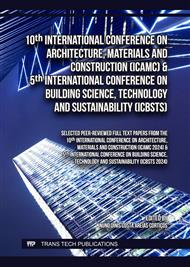p.19
p.27
p.33
p.41
p.47
p.55
p.65
p.73
p.83
Assessment of Mechanical and Physical Properties of Natural Hydraulic Binders Produced from Marls
Abstract:
In the 18th century, hydraulic-based binders gradually supplanted air-hardening binders, and by the early 20th century, these were eventually replaced by cement. The distinction between binders categorized as natural and other hydraulic binders, such as natural cement and conventional cement, is that the former is characterized by raw materials with a naturally favorable mineralogical composition. This study examined the experimental possibilities of natural hydraulic binder production with marl resources commonly found in Turkey. Two raw materials quarried from Mersin (M) and Adana (A) were selected. These raw materials were calcined at temperatures of 750-850-950-1050 °C. The X-ray diffraction (XRD) analysis indicates that while the binders produced with M-coded raw materials contain varying amounts of the hydraulic phases larnite (C2S and C3S), the A-coded binders exhibit an absence of these critical hydraulic phases, which are essential for strength development in hydraulic binder paste. The increase in the strength of A-coded binders is thought to be due to the formation of calcium silicate hydrate (C-S-H) phases, which result from the reaction between water, clay minerals (SiO₂, Al₂O₃, and Fe₂O₃), and hydrated lime (portlandite, Ca (OH)₂).
Info:
Periodical:
Pages:
47-53
Citation:
Online since:
January 2025
Authors:
Keywords:
Price:
Сopyright:
© 2025 Trans Tech Publications Ltd. All Rights Reserved
Share:
Citation:


